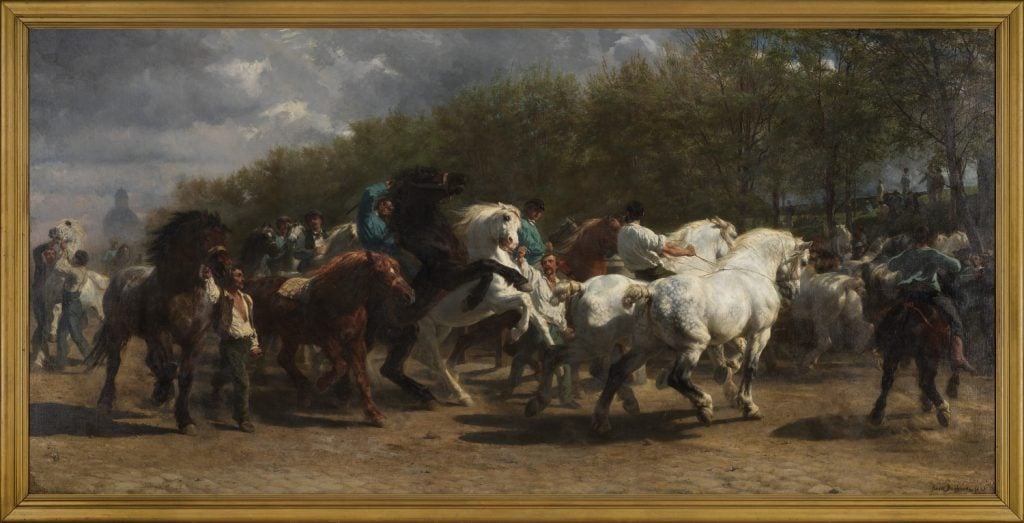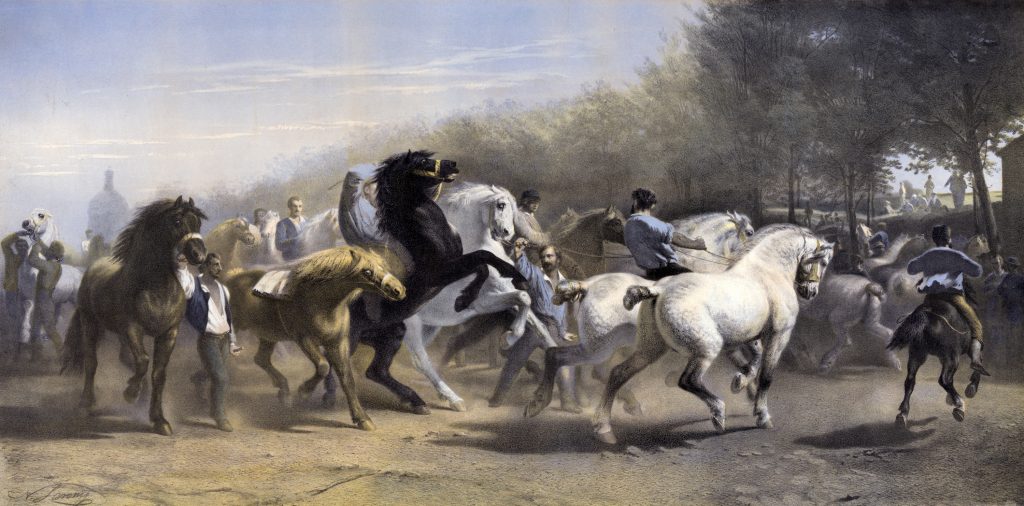Art World
Art Bites: Rosa Bonheur Had to Go Incognito to Paint ‘The Horse Fair’
The painting has been a highlight of the Met's collection since being donated in 1887.

What’s the deal with Leonardo’s harpsichord-viola? Why were Impressionists obsessed with the color purple? Art Bites brings you a surprising fact, lesser-known anecdote, or curious event from art history. These delightful nuggets shed light on the lives of famed artists and decode their practices, while adding new layers of intrigue to celebrated masterpieces.
“As far as males go, I only like the bulls I paint.” So said the 19th century’s most famous female painter, Rosa Bonheur. A curious quirk then, that her best-known work contains no bulls and rather a lot of men.
The Horse Fair (1852) was the sensation of the Paris Salon in 1853. The monumental Realist painting would have received a gold medal, but Bonheur had already claimed that once-in-a-lifetime prize in 1849. Rapidly issued prints would spread the kinetic scene, and the name of the artist behind it, across the world.
Within France, Bonheur was already well-established having first exhibited at the Salon as a 19-year-old. But when it came to preparing sketches and studies for The Horse Fair, she did so incognito. Women were not allowed at the market (attested to by the absence of women in the painting) and so Bonheur applied for an official “cross-dressing permit” from the police.

Sketch From The Horse Fair, painted by Rosa Bonheur. Photo: Universal History Archive/Universal Images Group via Getty Images.
It was granted and so twice a week for 18 months, Bonheur donned pants and hardy boots and headed to the tree-lined Boulevard de l’Hôpital in Paris’s 13th arrondissement. Though certainly unconventional for the time, it was in keeping with Bonheur’s gender-defying lifestyle. She chain-smoked, drank, cropped her short, wore breaches, shirts, and ties, and lived alongside her partner Nathalie Micas for four decades.
Painting as a profession was stigmatized for women—France’s national art school only began accepting female students in the 1890s—and Bonheur’s cross-dressing granted an anonymity that allowed her to observe the horse fair and slaughterhouses without attracting attention.
It was precisely Bonheur’s level of detail that made The Horse Fair a success. Animal paintings were in vogue and here audiences saw nearly life-size horses with accurate musculature and eyes that were realistic rather than anthropomorphized.

Lithograph by N. Sarony after The Horse Fair by Rosa Bonheur, published by J.M. Emerson, New York. Photo: VCG Wilson/Corbis via Getty Images.
Also key was the scene’s dynamism. In the era before automobiles, horses were the primary mode of urban travel and prospectors would come daily to watch the procession of horses. Bonheur captures this circular movement both in composition and through the play of dust and light and shadow.
In addition to Théodore Gericault and master horse painter George Stubbs, Bonheur cited Greek sculpture as an influence, calling the painting her version of the Parthenon Frieze (examples of which were on display at the Louvre). It’s easy to see why. The gleaming white horse that rears up in the painting’s center appears taken straight from the marbles.
Bonheur revised The Horse Fair repeatedly, including after its Salon showing (the lower right reads “1853. 5,” i.e. 1855). She had hoped her home city of Bordeaux would buy it (at the cut-price she offered), but when it refused, she sold it to British art dealer Ernest Gambart. The painting toured England extensively, including receiving an audience with Queen Victoria in Buckingham Palace.

Édouard-Louis Dubufe, Portrait de Rosa Bonheur (1857). © RMN-Grand Palais (Château de Versailles) / photo Gérard Blot.
By 1857, it had crossed the Atlantic and changed hands twice before Cornelius Vanderbilt bought it in 1887 for $53,000 (approximately $1.7 million today). He immediately gifted it to the Metropolitan Museum of Art where it became one of the museum’s most treasured items, as it remains today.
A marker of The Horse Fair’s status came in 1914 when the Red Cross took over Madison Square Garden for a fundraiser. It recreated Bonheur’s painting, a tableau vivant complete with an operatic chorus that sang to the clang of anvils. The New York Times called it the “hit of the evening.”





